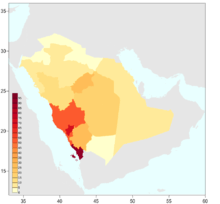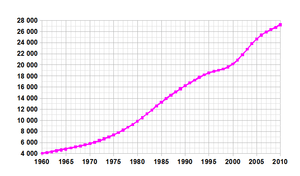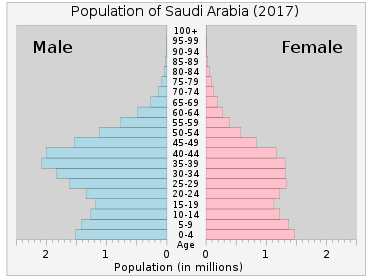Demographics of Saudi Arabia
The Kingdom of Saudi Arabia is the fourth largest state in the Arab world, with a reported population of 33,413,660 as of 2018.[6] A significant percentage of the nation's inhabitants are immigrants seeking economic opportunity, making up 37% of the total Saudi population.[7] Saudi Arabia has experienced a population explosion in the last 40 years,[8] and continues to grow at a rate of 1.63% per year.[7]
| Demographics of Saudi Arabia | |
|---|---|
 Saudi Arabia 2010 estimated population density. | |
| Population | 33,091,113 |
| Density | 15.322 people per sq. km of land (2017)[1] |
| Growth rate | 1.49% (2019 [2] |
| Birth rate | 14.7 births/1,000 population (2018) [3] |
| Death rate | 3.4 deaths/1,000 population |
| Life expectancy | 75.7 years |
| • male | 74.2 years |
| • female | 77.3 years |
| Fertility rate | 1.95 children born/woman (2020) [4] |
| Net migration rate | 590,000 (2017)[5] |
| Nationality | |
| Nationality | Saudi Arabia |
| Major ethnic | Saudis |
| Language | |
| Official | Arabic |
| Spoken | Arabic |

Until the 1960s, most of the population was nomadic or seminomadic; due to rapid economic and urban growth, more than 95% of the population is now settled. 80% of Saudis live in ten major urban centers—Riyadh, Jeddah, Mecca, Medina, Hofuf, Ta'if, Khobar, Yanbu, Dhahran, Dammam. [9] Some cities and oases have densities of more than 1,000 people per square kilometer (2,600/mile²). Saudi Arabia's population is characterized by rapid growth, far more men than women, and a large cohort of youths.
Saudi Arabia hosts one of the pillars of Islam, which obliges all Muslims to make the Hajj, or pilgrimage to Mecca, at least once during their lifetime if they are able to do so. The cultural environment in Saudi Arabia is highly conservative; the country adheres to the interpretation of Islamic religious law (Sharia). Cultural presentations must conform to narrowly defined standards of ethics.
Most Saudis are ethnically Arabs, the majority of whom are tribal Bedouins. According to a random survey, most would-be Saudis come from the Subcontinent and Arab countries.[10] Many Arabs from nearby countries are employed in the kingdom, particularly Egypt,[11] as the Egyptian community developed from the 1950s onwards.[12] There also are significant numbers of Asian expatriates, mostly from India, Pakistan, Bangladesh, Indonesia, Philippines, and recently refugees from Syria and Yemen. In the 1970s and 1980s, there was also a significant community of South Korean migrant labourers, numbering in the hundreds of thousands, but due rapid economic growth and development, most have since returned home; the South Korean government's statistics showed only 1,200 of their nationals living in the kingdom (most of them being professionals and business personnels) as of 2005.[13][14] There are more than 100,000 Westerners in Saudi Arabia, most of whom live in private compounds in the major cities such as Riyadh, Jeddah, Yanbu and Dhahran. The government prohibits non-Muslims from entering the cities of Mecca and Medinah.
Population
| Year | Pop. | ±% |
|---|---|---|
| 1950 | 3,121,000 | — |
| 1960 | 4,041,000 | +29.5% |
| 1970 | 5,772,000 | +42.8% |
| 1980 | 9,801,000 | +69.8% |
| 1990 | 16,139,000 | +64.7% |
| 2000 | 20,045,000 | +24.2% |
| 2010 | 27,448,000 | +36.9% |
| 2015 | 31,540,000 | +14.9% |
| Source:[15] | ||
As of 2018 the Kingdom of Saudi Arabia is estimated to have a population of 33,413,660 .[6]
Structure
The following data have been retrieved from the CIA World Factbook as of 2020.
Population Age Distribution
0–14 years: 24.84%
15–24 years: 15.38%
25–54 years: 50.2%
55–64 years: 5.95%
65 years and over: 3.63%
Sex Ratios

at birth: 1.05 male(s)/female
0–14 years: 1.04 male(s)/female
15–24 years: 1.09 male(s)/female
25–54 years: 1.52 male(s)/female
55–64 years: 1.61 male(s)/female
65 years and over: 1.12 male(s)/female
According to the CIA World Factbook the population of Saudi Arabia has a large young population ages 0–19 years and an increasing middle-age population ages 20–35 years.[7] With a growing population reaching adulthood, global economists and the Saudi government have become concerned that there are more Saudis seeking jobs than are available.[16] The nation has also seen a rise in its older population as life expectancy has risen throughout the last 40 years.[16]
Life Expectancy At Birth
The following data has been retrieved from the CIA World Factbook as of 2018.
total population:
male: 74.2 years
female: 77.3 years
| Period | Life expectancy in Years |
Period | Life expectancy in Years |
|---|---|---|---|
| 1950–1955 | 41.9 | 1985–1990 | 67.9 |
| 1955–1960 | 44.4 | 1990–1995 | 70.0 |
| 1960–1965 | 47.0 | 1995–2000 | 71.8 |
| 1965–1970 | 50.2 | 2000–2005 | 72.9 |
| 1970–1975 |
Density
Population Density: 15.322 people per km2 of land (2017)[1]
Growth
Vital Statistics
The following data have been retrieved from the CIA World Factbook as of 2020.
- Birth rate: 14.7 births/1,000 population [17]
- Death rate: 3.4 deaths/1,000 population
- Maternal mortality rate: 17 deaths/100,000 live births
- Infant mortality rate:
- male: 12.2 deaths/1,000 live births
- female: 10.4 deaths/1,000 live births
- Total fertility rate: 1.95 children born/woman[4]
Saudi Arabia is ranked 111th in comparison to the world with a birth rate of 18.51 births per 1,000 people in 2019.[17] The nation's death rate is ranked 220th worldwide with 3.3 deaths per 1,000 people.[7] Although birth rates have decreased in the last two decades, rates of decline fail to match the significant decline in death rates.[18] Because of this, Saudi Arabia has experienced a population explosion in the last 40 years,[8] and continues to grow at a rate of 1.63% per year.[7] Saudi Arabia's population growth continues to be 0.295% higher than population growth rates in the Middle East and North Africa.[19] Infant mortality rates have declined dramatically in the past twenty years from 25.3 deaths per 1,000 live births in 1995 to 6.3 deaths in 2017, according to the World Bank.[20] Saudi Arabia has a substantially lower infant mortality rate in comparison to the Middle East and North Africa region, which continues to face a high of 19.3 deaths for every 1,000 live births as of 2017. This significant reduction can be attributed to rising access to modern healthcare across the country, ranking 26th worldwide for healthcare system quality.[21] The construction of new hospitals and primary healthcare centers across the Kingdom, as well as healthcare during pregnancy and increased use of vaccinations account for a decline in infant mortality and increased life expectancy.[22]
UN estimates
| Period | Live births per year | Deaths per year | Natural change per year | CBR1 | CDR1 | NC1 | TFR1 | IMR1 |
|---|---|---|---|---|---|---|---|---|
| 1950–1955 | 158,000 | 81,000 | 78,000 | 47.9 | 24.3 | 23.5 | 7.18 | 204.3 |
| 1955–1960 | 180,000 | 83,000 | 98,000 | 47.6 | 21.9 | 25.7 | 7.18 | 183.1 |
| 1960–1965 | 210,000 | 86,000 | 124,000 | 47.6 | 19.6 | 28.1 | 7.26 | 162.6 |
| 1965–1970 | 248,000 | 88,000 | 159,000 | 46.9 | 16.7 | 30.2 | 7.26 | 139.2 |
| 1970–1975 | 304,000 | 88,000 | 216,000 | 46.4 | 13.4 | 33.0 | 7.30 | 106.6 |
| 1975–1980 | 378,000 | 86,000 | 292,000 | 44.1 | 10.0 | 34.1 | 7.28 | 78.2 |
| 1980–1985 | 491,000 | 86,000 | 405,000 | 42.7 | 7.5 | 35.2 | 7.02 | 57.0 |
| 1985–1990 | 562,000 | 86,000 | 476,000 | 38.3 | 5.8 | 32.4 | 6.22 | 42.3 |
| 1990–1995 | 579,000 | 85,000 | 495,000 | 33.5 | 4.9 | 28.6 | 5.45 | 30.2 |
| 1995–2000 | 573,000 | 87,000 | 486,000 | 29.7 | 4.5 | 25.2 | 4.51 | 22.2 |
| 2000–2005 | 545,000 | 91,000 | 454,000 | 24.7 | 4.1 | 20.6 | 3.54 | 19.4 |
| 2005–2010 | 569,000 | 98,000 | 470,000 | 22.1 | 3.8 | 18.3 | 3.03 | 18.5 |
| 1 CBR = crude birth rate (per 1000); CDR = crude death rate (per 1000); NC = natural change (per 1000); TFR = total fertility rate (number of children per woman); IMR = infant mortality rate per 1000 births[23] | ||||||||
Nationality and Ethnicity
Nationality
noun:
Saudi(s)
adjective:
Saudi or Saudi Arabian
Urbanization
The following data has been retrieved from the CIA World Factbook
urban population: 83.8% of total population (2018)
rate of urbanization: 2.17% annual rate of change (2015-20 est.)
Historically, the population of Saudi Arabia followed a nomadic lifestyle. Following the discovery of oil in the 1930s, the Kingdom became far more settled as people moved to centers of high economic activity.[7] Significant population growth can be seen in the rise of urbanization throughout Saudi Arabia, which has grown 2 percent in the past ten years.[25] The largest Saudi cities have become flooded with new residents as more people move to urban cities to find better employment opportunities, and overcrowding has become a major issue across the nation.[25]
Migration
Migration is a significant part of Saudi Arabia's society and culture, as the nation's thriving oil economy attracts large numbers of foreign workers from an assortment of countries throughout Asia and the Arab world.[4] Following economic diversification in response to the oil boom of the 1970s, the Saudi government encouraged skilled and semi-skilled workers to enter the Kingdom as the demand for infrastructure and development intensified.[26] Saudi Arabia is among the top five immigrant destination countries around the world, currently hosting 5.3 million international migrants in its borders. In 2017 non-native residents accounted for 37% of the Kingdom's total population, more than twice that of the United States whose immigrants make up 15% of the nation's total population.[27] The majority of Saudi Arabia's foreign born population are males between the ages of 25 and 45. These immigrants make up a larger percentage of the total population in this age group compared to native-born Saudis ages 25–45, according to the United Nations 2013 report.[28] 26.3% of the total migrant population in Saudi Arabia are from India, followed by Pakistan (24.2%), Bangladesh (19.5%), Egypt (19.3%), and finally the Philippines (15.3%).[28] Most immigrants of the Kingdom are skilled, unskilled, and service industry foreign workers. Although the living and working conditions immigrant workers are harsh in Saudi Arabia, economic opportunity tends to be much greater than in their homelands.[4] There are around five million illegal immigrants in Saudi Arabia, most of which come from Africa and Asia. These immigrants are planned to be deported within the next few years.[29][30] There are around 100,000 Westerners in Saudi Arabia, most of whom live in compounds or gated communities.
People from other immigration jurisdictions
| Nationality | Residents |
|---|---|
| Indians | 2,550,000 |
| Syria | 500,000-2,500,000[31][32] |
| Pakistan | 3,900,000 |
| Philippines | 1,600,000 |
| Bangladesh | 1,300,000 |
| Yemen | >1,000,000[33][34] |
| Egypt | 900,000 |
| Indonesia | 850,000 |
| Myanmar | 500,000 (Rohingya)[35][36] |
| Sri Lanka | 350,000 |
| Nepal | 315,000 |
| Lebanon | 300,000 |
| Jordan/Palestine | 260,000 |
| Sudan | 250,000 |
| Turkey | 200,000 |
| Somalia | 65,000[37] |
Religion
The government does not conduct census on religion, but estimates put the percentage of the majority Sunnis at 85-90%.[4] The rest are other forms of islamic minorities. Other smaller communities (Ismailis and Zaidis) reside in the south, with Ismailis constituting around half of the population of the province of Nejran, and a small percentage of the Holy Islamic cities of Mecca and Medina. There is also a Christian population of uncertain size. According to Gallup atheists account for 5% of the population with a total non-religious population of 24%.[38][39][40]
Languages
The official language of Saudi Arabia is Arabic. Saudi Sign Language is the principal language of the deaf community. The large expatriate communities also speak their own languages, the most numerous of which are Hindi (1,000,000), Indonesian (850,000), Filipino/Tagalog (700,000), Malayalam (447,000), Rohingya (400,000), Urdu (380,000), and Egyptian Arabic (300,000).[41][42][43]
References
- "Population density (people per sq. km of land area) | Data". data.worldbank.org. Retrieved 2018-12-01.
- "Saudi Arabia Population 2019". worldpopulationreview.com. Retrieved 2019-06-16.
- "Middle East :: Saudi Arabia - The World Factbook - Central Intelligence Agency". cia.gov. Retrieved 2020-04-15.
- Long, David (2010). The Kingdom of Saudi Arabia. University Press of Florida. pp. 23–24.
- "Net migration | Data". data.worldbank.org. Retrieved 2018-12-01.
- "The total population in 2018". general authority for statistics (Saudi Arabia). Archived from the original on 2019-04-03.
- "The World Factbook: Saudi Arabia". Central Intelligence Agency. November 13, 2018. Retrieved November 26, 2018.
- Zuhur, Sherifa. Saudi Arabia (Middle East in Focus). ABC-CLIO Interactive, 2011.
- House, Karen Elliott (2012). On Saudi Arabia: Its People, past, Religion, Fault Lines and Future. Knopf. p. 69.
- Siraj Wahab (30 July 2009). "It's another kind of Saudization". Arab News. Retrieved 13 January 2011.
- Tsourapas, Gerasimos (2015-11-10). "Why Do States Develop Multi-tier Emigrant Policies? Evidence from Egypt". Journal of Ethnic and Migration Studies. 41 (13): 2192–2214. doi:10.1080/1369183X.2015.1049940. ISSN 1369-183X.
- Tsourapas, Gerasimos (2016-07-02). "Nasser's Educators and Agitators across al-Watan al-'Arabi: Tracing the Foreign Policy Importance of Egyptian Regional Migration, 1952-1967". British Journal of Middle Eastern Studies. 43 (3): 324–341. doi:10.1080/13530194.2015.1102708. ISSN 1353-0194.
- Seok, Hyunho (1991). "Korean migrant workers to the Middle East". In Gunatilleke, Godfrey (ed.). Migration to the Arab World: Experience of Returning Migrants. United Nations University Press. pp. 56–103. ISBN 9280807455.
- "President Roh Moo-hyun's Official Visit to the Kingdom of Saudi Arabia". Cheongwadae (Office of the President), Republic of Korea. 2007. Archived from the original on 2007-07-08. Retrieved 2007-04-23.
- "World Population Prospects - Population Division - United Nations". Archived from the original on 7 May 2011. Retrieved 29 January 2016.
- Long, David (2010). The Kingdom of Saudi Arabia. University Press of Florida. pp. 18–19.
- "Saudi Arabia Population 2019". worldpopulationreview.com. Retrieved 2019-06-16.
- Long, David (2010). The Kingdom of Saudi Arabia. University Press of Florida. p. 66.
- “Population Growth (Annual %).” Population Growth (Annual %) | Data, World Bank , data.worldbank.org/indicator/SP.POP.GROW?end=2017&locations=ZQ-SA-US&start=1995.
- “Mortality Rate, Infant (per 1,000 Live Births).” World Bank: Infant Mortality , World Bank , data.worldbank.org/indicator/SP.DYN.IMRT.IN?end=2017&locations=SA-ZQ&start=1995.
- Kingdom of Saudi Arabia, “1st Voluntary National Review.” Sustainable Development Goals, United Nations High-Level Political Forum, 2017, pp 45-46.
- Kingdom of Saudi Arabia, “1st Voluntary National Review.” Sustainable Development Goals, United Nations High-Level Political Forum, 2017, pp 46-48
- World Population Prospects: The 2015 Revision Archived May 6, 2011, at the Wayback Machine
- "Middle East :: SAUDI ARABIA". CIA The World Factbook.
- "Saudi Arabia - total population from 2012 to 2022 | Statistic". Statista. Retrieved 2018-11-26.
- De Bel-Air, Françoise (January 2014). "Demography, Migration and Labour Market in Saudi Arabia". Migration Policy Center: European University Institute – via Gulf Research Center.
- “International Migration Report 2017.” Department of Economic and Social Affairs, United Nations, 2017, www.un.org/en/development/desa/population/migration/publications/migrationreport/docs/MigrationReport2017_Highlights.pdf.
- “Migration Profile: Saudi Arabia .” Unicef , United Nations , 2013, esa.un.org/miggmgprofiles/indicators/files/saudiarabia.pdf.
- https://sputniknews.com/middleeast/201703121051505952-saudi-migrants-deportation/
- http://english.alarabiya.net/en/News/gulf/2017/03/07/Saudi-Shoura-Council-considers-deporting-5-mln-illegal-migrants.html
- Doanvo, Anhvinh (23 September 2015). "Western Media's Miscount of Saudi Arabia's Syrian Refugees". Huffington Post.
- http://www.arabnews.com/saudi-arabia/news/843191
- "Archived copy". Archived from the original on 2017-03-08. Retrieved 2017-03-07.CS1 maint: archived copy as title (link)
- https://www.bbc.com/news/world-asia-41566561
- "Saudi Arabia entry at Ethnologue". Ethnologue. Retrieved 6 February 2015.
- "Dubai's Somali diaspora hope for change". CCTV. 11 September 2012. Archived from the original on 2015-07-01. Retrieved 8 March 2015.
- "Global Index of Religiosity and Atheism" (PDF). Gallup. Retrieved 2013-08-06.
- "A surprising map of where the world's atheists live". Washington Post. Retrieved 2014-05-18.
- "Atheism explodes in Saudi Arabia, despite state-enforced ban". Salon. Retrieved 2014-06-14.
- "Migrant Communities in Saudi Arabia", Bad Dreams: Exploitation and Abuse of Migrant Workers in Saudi Arabia, Human Rights Watch, 2004
- Saudi Arabia. Ethnologue
- Kerala Gulf diaspora
